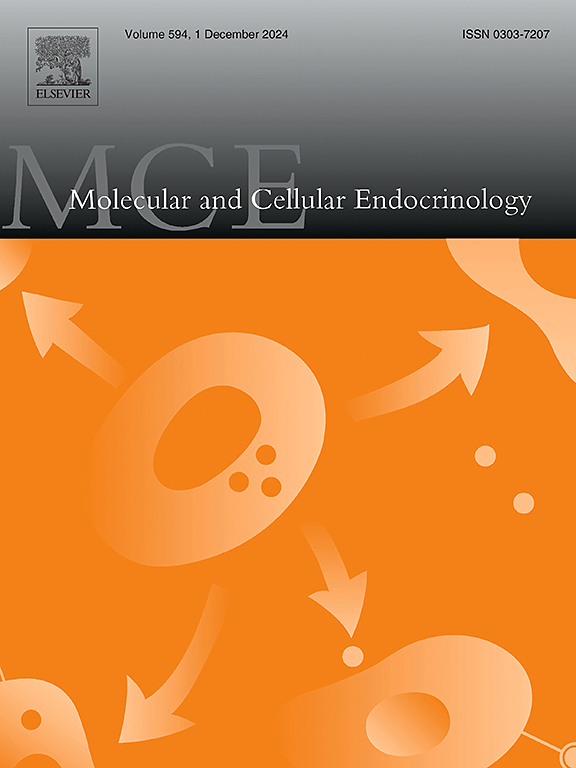PPM1G dephosphorylates α-catenin to maintain the integrity of adherens junctions and regulates apoptosis in Sertoli cells
IF 3.8
3区 医学
Q2 CELL BIOLOGY
引用次数: 0
Abstract
Protein phosphatase, Mg2+/Mn2+ dependent, 1G (PPM1G) regulates protein function via dephosphorylation. PPM1G participates in the assembly of adherens junctions by dephosphorylating α-catenin. Here, we demonstrated through siRNA transfection and intratesticular injection that PPM1G is critical for maintaining blood-testis barrier function and regulating Sertoli cell apoptosis. We observed that upon knocking down Ppm1g in rat testes, the function of the blood testis barrier was compromised, and the localization of α-catenin and β-catenin became aberrant. Further investigation in rat Sertoli cells revealed that after Ppm1g knockdown, the level of phosphorylated α-catenin increased, and it failed to properly aggregate at the cell membrane; instead, it was mislocalized to the cytoplasm. The actin to which catenin is attached also exhibited a disordered arrangement in the absence of PPM1G. Additionally, through RNA sequencing and bioinformatics analysis, we identified genes associated with Sertoli cell dysfunction induced by Ppm1g knockdown and identified a set of genes involved in regulating intercellular junctions. Subsequent validation revealed that after Ppm1g knockdown, the expression of the junction-related protein JAM2 was reduced, and Sertoli cells underwent apoptosis. Overall, we identified a gene, Ppm1g, which may be involved in maintaining the normal function of the blood-testis barrier and influencing the survival of Sertoli cells by regulating apoptotic pathways.

PPM1G可使α-连环蛋白去磷酸化,维持粘附体连接的完整性,并调节支持细胞的凋亡。
蛋白磷酸酶,Mg2+/Mn2+依赖性,1G (PPM1G)通过去磷酸化调节蛋白功能。PPM1G通过去磷酸化α-连环蛋白参与粘附连接的组装。在这里,我们通过siRNA转染和睾丸内注射证明PPM1G对于维持血睾丸屏障功能和调节支持细胞凋亡至关重要。我们观察到,在大鼠睾丸中敲低Ppm1g后,血睾屏障功能受损,α-catenin和β-catenin的定位发生异常。在大鼠Sertoli细胞中进一步研究发现,Ppm1g敲低后,磷酸化的α-catenin水平升高,且不能在细胞膜上正常聚集;相反,它被错误地定位在细胞质上。在缺乏PPM1G的情况下,与连环蛋白相连的肌动蛋白也表现出无序排列。此外,通过RNA测序和生物信息学分析,我们鉴定了Ppm1g敲低诱导的支持细胞功能障碍相关基因,并鉴定了一组参与调节细胞间连接的基因。随后的验证表明,Ppm1g敲低后,连接相关蛋白JAM2的表达降低,Sertoli细胞发生凋亡。总的来说,我们发现了一个基因Ppm1g,它可能参与维持血睾丸屏障的正常功能,并通过调节凋亡途径影响支持细胞的存活。
本文章由计算机程序翻译,如有差异,请以英文原文为准。
求助全文
约1分钟内获得全文
求助全文
来源期刊

Molecular and Cellular Endocrinology
医学-内分泌学与代谢
CiteScore
9.00
自引率
2.40%
发文量
174
审稿时长
42 days
期刊介绍:
Molecular and Cellular Endocrinology was established in 1974 to meet the demand for integrated publication on all aspects related to the genetic and biochemical effects, synthesis and secretions of extracellular signals (hormones, neurotransmitters, etc.) and to the understanding of cellular regulatory mechanisms involved in hormonal control.
 求助内容:
求助内容: 应助结果提醒方式:
应助结果提醒方式:


